Halt and Catch Spareribs
I fell in love with the TV show Halt and Catch Fire and felt a keen sense of grief when I'd seen the last episode. The characters had come to seem very much like real people to me, and I acutely missed having them in my life. Plus, the show's star, Lee Pace, is mesmerizing and magnetic and ... sigh. Bereft of my nightly fix, I wanted to see everything he has done. Strangely, following that trail seems to have brought me closer not only to him but also to Japanese and kanji!
I should say that at various points in Halt, three characters speak Japanese. Lee Pace isn't one of them, but he does in his guest spot on The Mindy Project. Several characters also speak Japanese in the second episode of his terrific and extremely quirky series Pushing Daisies. And then there's this:
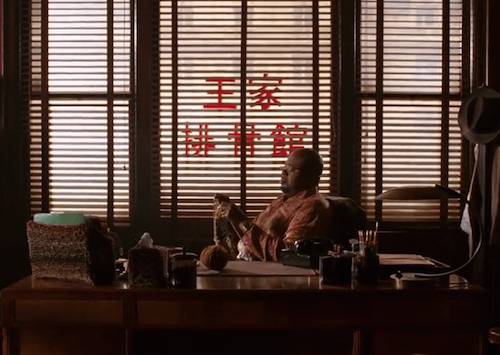
Pushing Daisies involves a private investigator named Emerson Cod who loves to knit ... and inexplicably has Chinese characters on the window of his office. Even stranger, they're facing the interior! I have no idea why they're there (but I've seen only five episodes, and maybe it will be revealed), but to me these characters may be even more distracting than the sight of Lee Pace himself.
All of these characters exist in Japanese:
王家
排骨館
As it turns out, the characters say Wang Family's House of Spareribs! Or the name could be Wong." Both are written with 王, but “Wang” is Mandarin, “Wong” Cantonese. By the way, in Tainan, Taiwan, there's a restaurant called 王家排骨飯.
My proofreader asked me whether the 骨 in the show is written like the one on the left or right here:
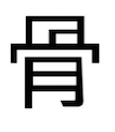
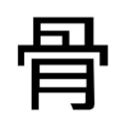
I don't know because every image I can find of Emerson Cod's window has a blocked view of the character! As I've learned, the lefthand one is Traditional Chinese, and the other is Simplified. Really? That's not simpler at all. I've never before encountered this kind of transformation in a Chinese character, and it has taken me quite by surprise.
I'm also surprised to learn that 排骨 is a word in both Chinese and Japanese:
Chinese: 排骨 (páigǔ: pork chop, pork cutlet, spareribs)
Japanese: 排骨 (パイクー or パイコー or パーコー: Chinese-style spareribs (esp. pork, also beef and lamb), breaded and fried)
Clearly, the Japanese term has come from the Chinese.
Long ago I wrote essay 1686 about 排 (to exclude, expel, reject; anti-; discharge, exhaust, drain; excrete), and as you can see from the definitions, this kanji often plays a role in terms about getting rid of toxic substances, such as exhaust fumes. Why would it precede 骨 (bone) here? Is the idea that the rib bone (骨) has been extracted (排, kind of) from the pig's body?
My proofreader says, "This is just my gut feeling, but the primary definition of the hanzi 排 is 'to form a line; line up,' as in 排隊 (to stand in line). Rib bones are lined up (in a manner of speaking) around the chest, so that’s got to be why."
As long as we're talking about Chinese characters, I want to introduce this fun word:
眉山 (まゆやま: peak of the arch of an eyebrow) eyebrow + mountain
I wonder why anyone ever needed such a specific term!
There is, of course, a Lee Pace connection here. On Halt, his character's underlings have rather cruelly nicknamed their boss Admiral Eyebrows because of his notably bushy eyebrows. The Japanese have another great word for that:
蚰蜒眉 (げじげじまゆ: bushy eyebrows)
millipede + meandering, serpentine + eyebrows
Check out that breakdown! The first two kanji are non-Joyo, so I don't know much about them except that they feature the "insect" radical 虫. Buggy brows!
It may sound to you as if I haven't been very disciplined, what with all this TV viewing and subsequent Googling, and you may have a point! Still, since we last met here I've come out with essay 1288 on 宰 (to be in charge) and essay 2119 on 冶 (to work metals), as well as supplemental Radical Notes. Here are sneak previews:
Radical Note 40 on 宀, the "katakana u" radical
Radical Note 15 on 冫, the "ice" radical
Actually, the second essay topic has a lot to do with discipline. When blacksmiths heat up iron and then hammer it into shape (which is mainly what blacksmiths do, as you can see in a video from Japan), that's called "training iron":
鉄を鍛える (てつをきたえる: to forge iron) iron + to train
The verb 鍛える also means "to discipline." It has never occurred to me to discipline iron!
By writing essay 2119 I also realized that the blacksmith's hammering process inspired the English phrase "to strike while the iron is hot." That literally means "to strike a hot piece of metal, especially iron, with a mallet or other tool while the metal is still hot enough to be shaped." Figuratively the idiom means "to jump at an opportunity promptly while it's available." As for the expression "to have lots of irons in the fire," that comes from a blacksmith's working on several pieces at the same time.
From TV I'm learning about Chinese, from which I'm learning about Japanese, from which I'm learning about English! Who says TV is bad for the brain?
Catch you back here next time!
❖❖❖
Did you like this post? Express your love by supporting Joy o' Kanji on Patreon:

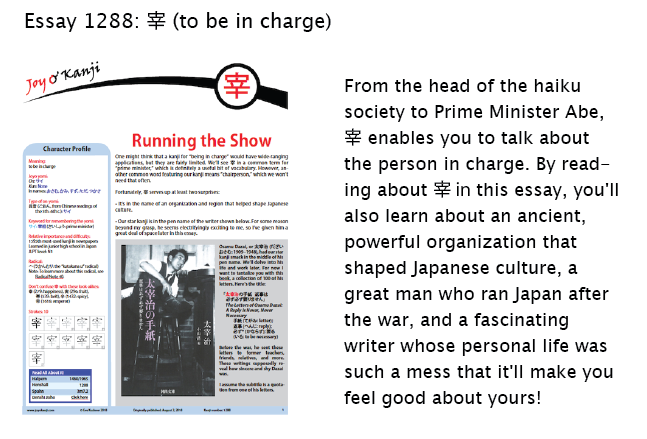
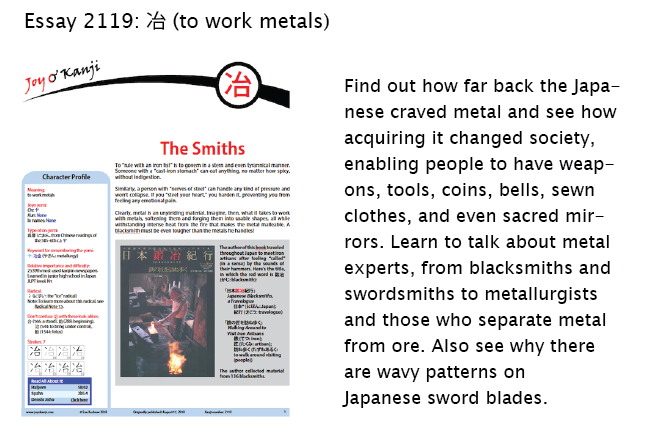

Comments